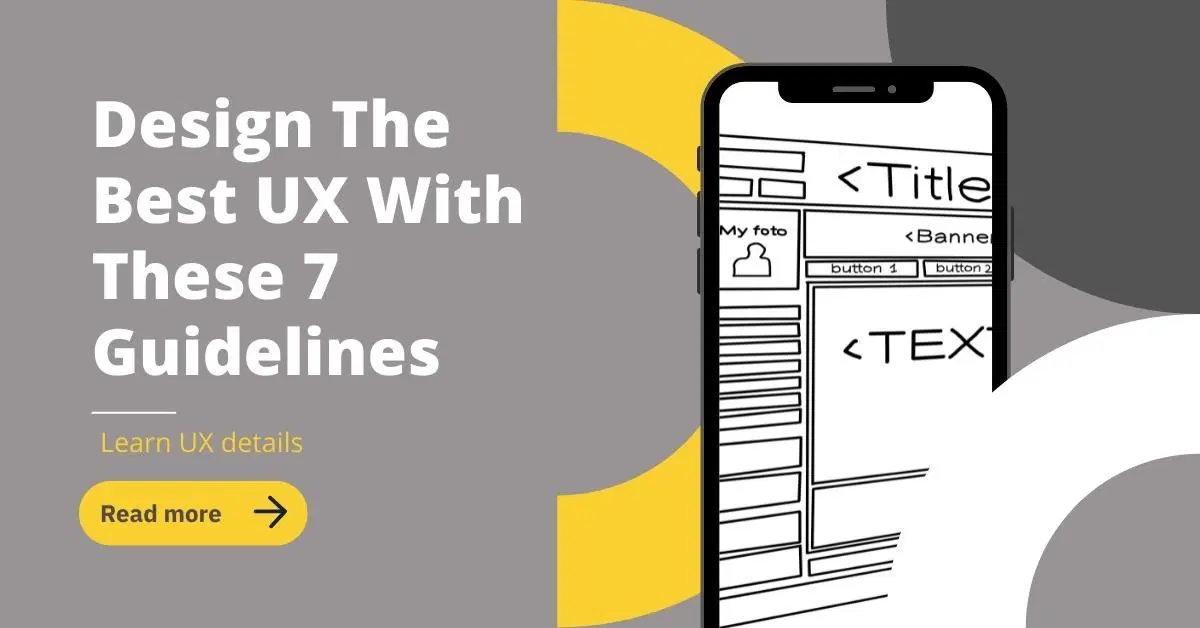
User experience design (UXD) focuses on improving the usability, ease of use, and pleasure provided in the interaction between the user and the product. The goal is to enhance utility with a simple, engaging customer experience so people will want to use it.
User experience design combines research, creative thinking, information architecture, programming skills, and a deep understanding of the target audience to create a product that people will enjoy using. It considers the context in which people use a product by observing how they do their jobs and feel about it. UXD is more than just designing what a website or app looks like; it's also responsible for creating an interactive, meaningful system that enables users to accomplish their tasks efficiently and successfully.
What Techniques Are Used To Create An Engaging UX?
Some techniques for creating an engaging UX include:
- Visual hierarchy - Scannability - Familiarity - Consistency
Visual hierarchy
The order in which information is presented to the user, such as headings and sub-headings, should be designed to make sense. Providing a clear direction or path for users to follow when finding or consuming content will aid engagement. It is essential for users to quickly understand how the page is organized.
Scannability
Ensuring critical elements are easy to find on a screen by making items large enough for maximum contrast with their background color. Elements should be widely spaced apart from each other to be easily seen. This reduces the cognitive load on the eyes, which reduces mental fatigue over an extended period.
Familiarity
It is essential for software to be easy to learn and understand. This can be achieved by using familiar UX patterns, language, symbols, tools, etc. This should not take away from the uniqueness of your product but provide a comfortable starting point for users when they are introduced to it for the first time. Familiarity also reduces the learning curve, which takes away effort for users to become engaged in the product or website, which again increases engagement levels. Another benefit of familiarity is that it will keep retention rates high because people have an easier time remembering what to do next after being shown something only once due to cognitive biases that reduce mental fatigue, thus increasing user satisfaction with their experience on your site.
Consistency
Ensuring consistency in all aspects of your product, including design, language use, look and feel, etc., will aid the user experience. If users are uncertain about what to expect next or buttons aren't where they expect them to be, it can break their flow. If the user is constantly asking themselves questions like "where should I click?", "What now?", "this somewhat makes sense" then, they will create too much cognitive load, which reduces engagement levels as mental fatigue sets in.
What Should Be Your Primary Goal With Designing A User Experience?
A similar question should be taken into consideration: What is the more important thing to consider when creating a website, application, or even a specific feature of either one?
It really depends on what you want to achieve. For example, if you only wanted the most basic features such as navigation and didn't care much for aesthetics, then speed would probably be your number one priority. However, if you're site is still prolonged after implementing performance improvements. Then, it might be worth considering making it look nicer and more inviting to make users more likely to come back in the future and keep using it.
Design The Best User Experience With These 7 Guidelines
The fundamental elements of a perfect user experience, both on websites and mobile applications, go beyond just having an aesthetically pleasing interface.
Modern software design blurs the line between artistic expression and user-focused simplicity. If you're interested in crafting engaging products that are literally "user-friendly," continue reading this post to learn about seven key guidelines for creating the ultimate UX/UI.
1 - User Flow Design
Creating compelling product images is critical to your website or application's conversion rate potential. One psychological principle that makes images so impactful is priming, which can be defined as making people think about certain concepts without being aware they are doing it. This occurs when you show users an image of barbells before asking them to do some bicep curls, for example.
Since people priming works through visual means, it can influence the actions of people who see an image on a website or mobile app. For example, suppose you display a user interface that looks complicated and cluttered. In that case, people viewing it will feel intimidated and less likely to use your product. This is why it's important to ensure your images show users using your product simply and enjoyably. In other words, excellent user flow design affects how well people take action from seeing the picture.
2 - Mobile App Design
Most prime examples of bad UX/UI are found in poorly designed apps for smartphones and tablets. These products represent the pinnacle of what could be possible in terms of UX/UI, so it's essential to try and understand where they fall short.
The biggest mistake that most mobile apps make is that they focus too much on the actual user interface. For example, suppose an app has an excellent design but doesn't get used very often. In that case, there is something wrong with the product's overall usability.
Designers should strive to create software that focuses on both good UI and great UX for a mobile app to be considered truly great. The best way to accomplish this is through prototyping. It allows you to get feedback from users early in the development process. This will enable programmers and graphic designers to quickly make changes until an application combines beautiful visuals with a functional user experience.
3 - Navigation And Interaction
Navigation is one of the most overlooked web and mobile app design aspects. Most designers polish their graphic interface while leaving the navigational components in an unorganized and disjointed state. This is a grave mistake since people will often abandon a product if they can't find what they are looking for or if navigating through it becomes too difficult.
There is no one-size-fits-all solution for creating intuitive navigational features for your website or application. Still, there are several things you should consider. For example, does your navigation system use visuals representing each of your primary categories? For instance, if someone lives in Atlanta and wants to go shopping, would they be able to find "Shopping" faster if it were represented by a shopping cart icon on the interface?
You should also ensure that your menus are structured logically. Having related items near each other makes them easier to find. You can separate sections of your site or application with sub-menus or drop-down panels, but make sure they don't contain more than seven items at most (otherwise, users will feel overwhelmed). Try to limit big blocks of text since they make it difficult for people to scan through what you've written; using bullet points or numbered lists is usually a better option.
4 - Designing Forms For User Input
One of the great things about prototyping user flow design before coding begins, is that it allows designers to try different input methods on users. This makes it easier to determine which text fields, drop-down menus, radio buttons, and checkboxes are the best options for your product.
For example, suppose you want people to signup or register with your website or application. In that case, you should make sure you ask only for the essential information (e.g., an email address and password) instead of making them fill out a long-form as they do on some websites these days. Of course, you can always get more granular data later on once someone has shown interest in what you have to offer.
The same philosophy applies when asking users for their credit card information online. Unfortunately, most sites will overwhelm customers by requiring too much sensitive data upfront. A better approach would be to only ask for the information required by your merchant account provider (e.g., a card number, expiration date, and CVV code). This allows customers to input their payment information more quickly without worrying about making mistakes.
5 - Testing Your Designs With Users
Asking people what they think of your user flow design before coding is essential if you want it to be successful. These days several new providers will help you conduct market research on designs, allowing you to get critical feedback from potential users early in the process so developers can make adjustments as necessary.
Remember, even millionaires like Mark Zuckerberg and Steve Jobs went through multiple stages of testing when designing products. They didn't just sit in a room with a team of designers and expect their ideas to be flawless. Instead, they sought the opinions of others so that they could create something with broad appeal.
Always try to get feedback on your designs from people outside your company. They must include people who don't have any experience with the industry you are trying to penetrate since this will help you avoid "groupthink."
6 - Optimizing User Experience With Visual Hierarchy
Design is all about making things look good for potential customers for most companies. However, there has been a surge in popularity around flat design in recent years, often characterized by its minimalistic aesthetic. This has led many product developers to focus more on visuals than functionality. Still, it may be a mistake to follow this trend if it's not what your users want.
Visual hierarchy is organizing content to get noticed by making some elements bigger or more colorful than others. This is incredibly important for user experience since no one likes visiting websites where they can't find anything because everything on the page looks similar.
Therefore, you should always communicate which key points are most critical for customers. You can do this by using flat colors that stand out against white backgrounds or using negative space in the right way to help people navigate through your product. Remember, design isn't just about how something looks but also how easy it is to quickly use and access information. If you fail at these objectives, you won't have a marketable product.
7 - Designing With The End In Mind
Last but not least, every company should always consider the full scope of what it is trying to accomplish before they begin building their product. This means that designers need to ask themselves whether their design makes sense for customers and business objectives. For example, suppose there's no apparent connection between branding and user experience. In that case, chances are your business model will fall apart over time.
This becomes even more important when entering crowded markets with many competitors because customers will expect the same quality as other products in your industry. For instance, if you own an online bank, you must understand what all your customers expect from doing business with your institution. If you don't, it will be all too easy for them to switch over to a new website that better meets their needs.
Remember, building a product is an iterative process. As you continue to do it, there are always changes that need to be made along the way. This means that you should always prioritize customer expectations before investing in marketing or branding because this will give your brand the best chance of success in increasingly competitive markets. And remember, making money isn't just about putting effort into the design but also focusing on user experience. There's no point in having professional developers create content without this crucial component.
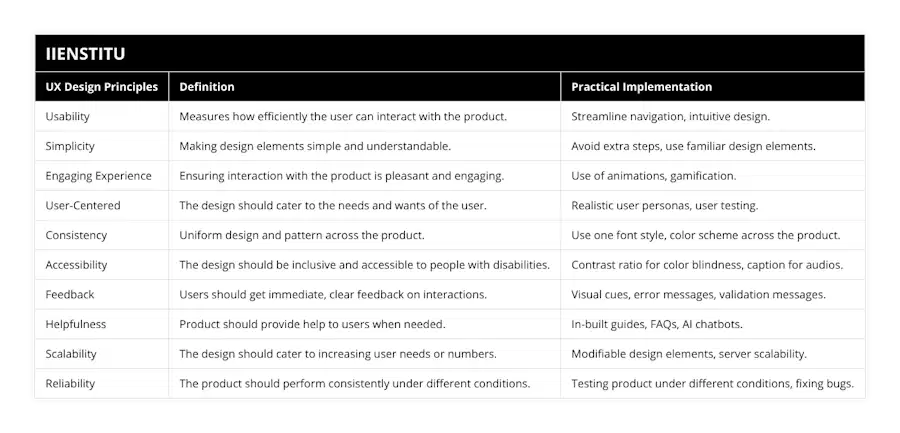
Frequently Asked Questions
What are the essential components of good UX design?
Defining Good UX Design
Good User Experience (UX) design is vital for the success of any digital product or website, as it determines how users interact with and perceive the system. To achieve exceptional UX, designers must consider several critical components.
Usability and Functionality
First, a good UX design ensures that the product or website is easy to use and understand. This means that it should have a clear layout, logical navigation, and concise instructions, allowing users to accomplish their tasks effortlessly. Additionally, a well-designed interface should also consider users with disabilities, catering to their needs and preferences.
Visual Aesthetics
Secondly, visual aesthetics play a significant role in UX design by shaping users' impressions and emotions. It involves using appropriate colors, typography, and imagery that resonate with the target audience while maintaining a consistent brand identity. This consistency throughout the design creates a sense of familiarity and trust with the user.
Content and Information Architecture
Another essential component is content, which should be structured in a clear, concise, and informative manner. A well-planned information architecture ensures users can locate the desired information easily, avoiding frustration and abandonment. Organizing content into meaningful categories and providing efficient search functionality significantly improves user satisfaction.
Responsive and Adaptive Design
With the increasing diversity of device types and screen sizes, it is crucial for a good UX design to adapt to various contexts. Responsive and adaptive designs ensure that the interface remains optimized across devices, delivering a seamless experience to users regardless of the device they use.
User Feedback and Iteration
Finally, good UX design is an ongoing process. Designers must continuously engage with users through feedback, user testing, and analytics to understand their needs, preferences, and pain points. By iterating and refining the design based on user input, designers can ensure that their products remain user-centered and aligned with evolving user expectations.
In summary, the essential components of a good UX design include usability, visual aesthetics, content, information architecture, adaptability, and user feedback integration. By considering these critical aspects, designers can create a user-centered, engaging, and efficient digital experience that enhances user satisfaction and product success.

How can UX best practices be effectively implemented in various design processes?
Understanding the User's Needs
To effectively implement UX best practices in various design processes, it is essential to have a deep understanding of the user's needs and desires. Conducting user research, such as interviews or surveys, can provide valuable insights into the target audience's preferences and behavior patterns. Utilizing these findings in design processes ensures that the final product effectively meets the user's requirements.
Collaborative Design Approach
Collaboration between UX designers, product managers, developers, and other team members is crucial in translating user needs into functional solutions. A collaborative design approach ensures that all stakeholders are involved in making key decisions, resulting in a more cohesive product that stays true to the established UX guidelines. By encouraging open communication and regular feedback, UX best practices can be seamlessly integrated into the design workflow.
Iterative Design Process
Incorporating UX best practices requires an iterative design process, which involves continuous feedback loops, prototyping, and testing. This enables designers to identify potential issues early, refine their designs, and make necessary adjustments according to the user's expectations. By adopting an iterative approach, designers can focus on both the user's needs and the overall design goals, resulting in a more effective and user-centric product.
Emphasis on Accessibility
An essential aspect of implementing UX best practices is ensuring that the designed product is accessible for all users, including those with disabilities. By adhering to accessibility guidelines and principles, designers can create inclusive interfaces and experiences that cater to a diverse range of users. Considering accessibility early in the design process can lead to a smoother implementation of UX best practices and deliver an optimal experience for all.
Design Evaluation and Metrics
Finally, evaluating the effectiveness of implemented UX best practices through design evaluations and metrics is crucial for continuous improvement. By tracking user feedback, monitoring UX metrics such as task completion rates, and conducting usability testing, designers can determine the areas of the design that need improvements. This data-driven approach facilitates continuous refinement of the design and supports the successful incorporation of UX best practices.
In conclusion, implementing UX best practices within various design processes can be achieved through understanding user needs, fostering collaboration, embracing iterative design, prioritizing accessibility, and performing regular evaluations. By adopting these principles, designers can create products that not only fulfill the end user's expectations but also elevate the overall user experience.
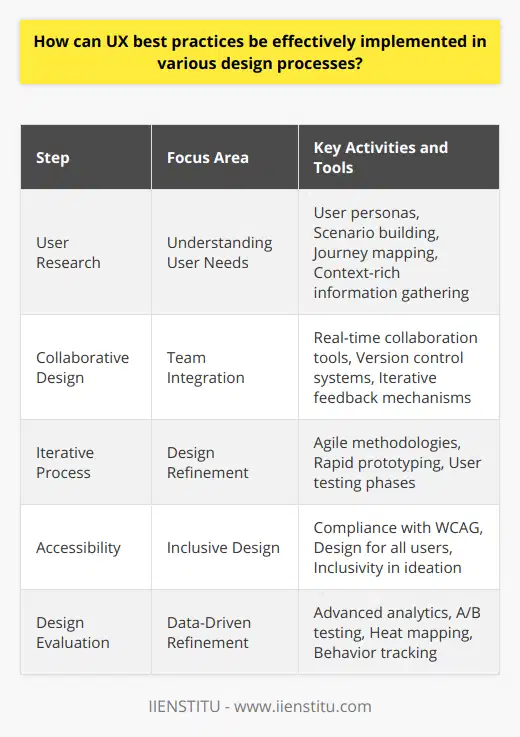
In what ways do UX guidelines contribute to the overall user experience and satisfaction?
Influence of UX Guidelines: Efficiency and Consistency
One of the critical ways that UX guidelines contribute to user experience and satisfaction is by offering efficiency and consistency throughout product or service usage. Consistent design elements, such as navigation menus and button placement, allow users to become familiar with the interface quickly, thereby reducing cognitive workload and increasing overall efficiency (McKay & Head, 2011).
Emotional Impact: Satisfaction and Trust
Moreover, UX guidelines also contribute to the emotive aspects of user experience. Adherence to established design principles, such as hierarchy, balance, and contrast, creates visually appealing interfaces (Jankun-Kelly, 2016). Aesthetically pleasing designs can evoke positive emotions among users, contributing to user satisfaction and enhancing trust in the product or service (Liang, 2018).
Error Reduction: Accessibility and Usability
Furthermore, implementing UX guidelines has a significant impact on reducing user errors, which consequently leads to a more satisfying user experience. By following established best practices for accessibility, designers can create interfaces that cater to a wide spectrum of abilities, reducing user frustration, and promoting greater inclusivity (Apple Inc., 2020). Additionally, incorporating usability principles, such as the use of affordances and meaningful feedback, promotes ease of use and minimizes system-associated errors (Preece et al., 2015).
User-Centric Approach: Empathy and Validation
Lastly, UX guidelines drive a user-centric approach to design, which places the end-user's needs and preferences at the center of design decisions. This approach fosters empathy among designers, ensuring that pain points and user frustrations are adequately addressed (Brown, 2009). The validation and testing of the designed interface, as specified by UX guidelines, ensures that the product or service remains relevant to the target user base, subsequently enhancing user satisfaction (Norman, 2013).
In conclusion, the adherence to UX guidelines plays a decisive role in delivering a satisfactory user experience by fostering efficiency, eliciting positive emotions, reducing errors, and promoting user-centric design processes.
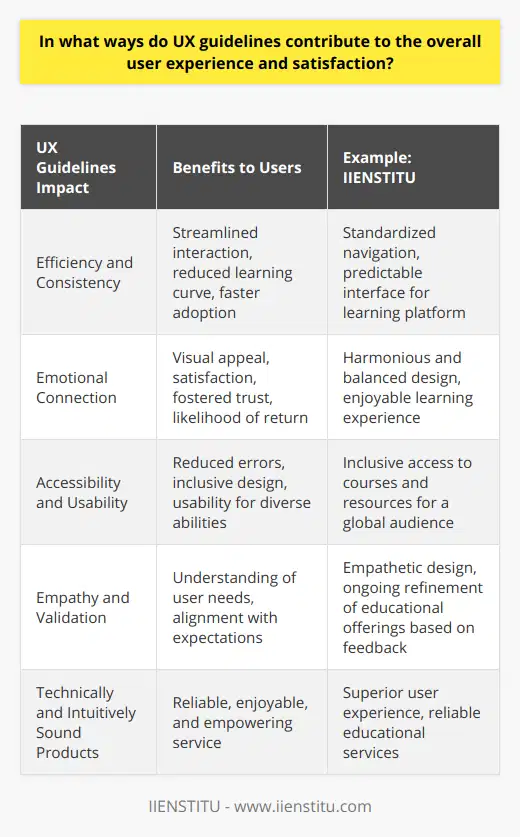
What are the best practices in UX design for creating an engaging and user-friendly digital product?
Understanding User Needs
The best practices in UX design for creating an engaging and user-friendly digital product revolve around understanding user needs, preferences, and characteristics. Conducting user research is vital, as it provides valuable insights into users' goals, behaviors, and pain points. Comprehensive user research can be achieved through interviews, surveys, and usability tests.
Iterative Design Cycles
Another essential practice is employing iterative design cycles. Iterative design involves creating a prototype, testing it with users, collecting feedback, refining the design, and repeating the process until the product meets users’ expectations. This continuous cycle of designing and refining the product based on user feedback ensures that the final output is user-centered and fulfilling its purpose.
Consistency and Predictability
Consistency and predictability in the layout, design elements, and navigation system are crucial for creating a user-friendly digital product. Establishing a consistent appearance across the product allows users to build familiarity and gain confidence in their interactions. Predictability refers to creating intuitive and logical UX elements that cater to users' expectations, ensuring a seamless and effortless user experience.
Accessibility for All Users
An engaging and user-friendly digital product should be accessible to all users, regardless of their abilities or disabilities. Incorporating accessibility features and guidelines in the design process ensures a diverse range of users can access and navigate the product with ease. This includes adhering to Web Content Accessibility Guidelines (WCAG) and considering factors such as color contrast, font size, and keyboard navigation.
Clear and Concise Content
The content of a digital product plays a significant role in engaging and retaining users. Clear and concise content provides users with the information they need without overwhelming them. This can be achieved by using simple language, hierarchical content structure, and breaking up long sections of text with visuals or white space.
Effective Visual Design
Visual design elements, such as color, typography, and imagery, contribute to the overall user experience. Effective visual design can increase a product’s usability by clearly conveying information, setting the right tone, and guiding users’ attention to essential elements. Attention must be given to choosing the right color palette, typography, and visual assets that align with the product’s purpose and target audience.
In conclusion, creating an engaging and user-friendly digital product requires a deep understanding of user needs, iterative design cycles, consistency, accessibility, clear content, and effective visual design. Incorporating these best practices ensures a seamless and enjoyable user experience, leading to satisfied and loyal users.
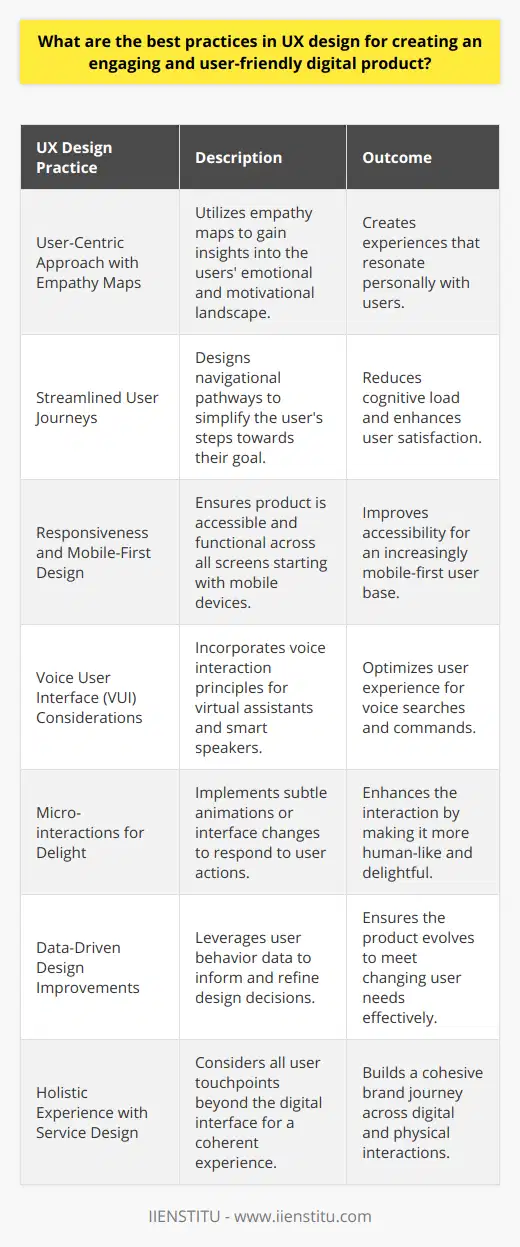
How do the 7 principles of UX design impact the overall effectiveness and success of an interactive platform?
Impact of UX Design Principles
User Experience (UX) design is crucial in creating an effective, successful interactive platform. By adhering to the seven principles of UX design, it enhances the overall user experience, ensuring better functionality and user satisfaction.
Enhancing Usability
The first principle, usability, focuses on making the platform easy and efficient to use. When users can quickly accomplish their goals, the platform's effectiveness and chances of success increase.
Improving Accessibility
Accessibility, the second principle, aims to make the platform usable by individuals with varying abilities. By considering users with disabilities or impairments, designers can create a more inclusive platform, leading to an expanded user base and greater satisfaction levels.
Consistency and Familiarity
Ensuring consistency and familiarity in design elements is the third principle. By utilizing familiar layouts and patterns, users can navigate the platform more easily, improving effectiveness and encouraging return visits.
Communicative Design
The fourth principle is to create a design that communicates effectively with users. Clear, concise instructions and guidance can enhance the user experience and minimize confusion or frustration, supporting the platform's success.
Avoiding Errors
Minimizing errors is the fifth principle. By incorporating intuitive design and anticipating user needs, designers can reduce the possibility of error, leading to a more seamless and enjoyable user experience.
Flexibility and Adaptability
The sixth principle, flexibility and adaptability, focuses on creating a platform that caters to varying user preferences and situations. By offering customization and personalization options, users are more likely to engage with the platform and find value in its offerings.
Sustained Engagement
Lastly, the seventh principle is to promote sustained engagement with the platform. By continuously evaluating and refining the design, designers can create a platform that delights users and ensures ongoing success.
In conclusion, the seven principles of UX design play a pivotal role in determining the overall effectiveness and success of an interactive platform. By focusing on usability, accessibility, consistency, communication, error prevention, flexibility, and sustained engagement, designers can create platforms that provide enjoyable and satisfying experiences for users, ensuring their success in the long run.
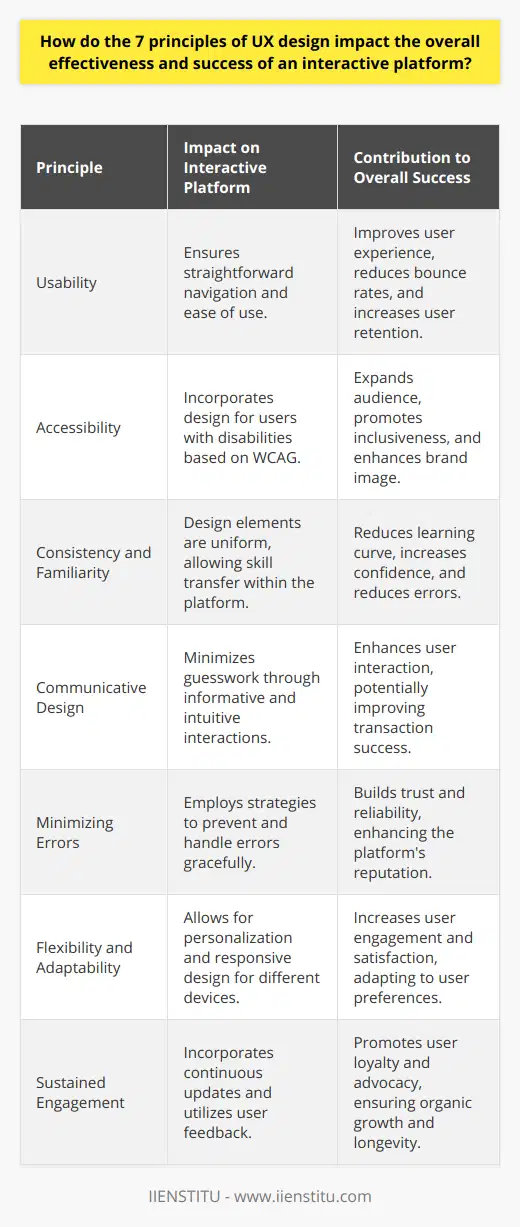
In what ways do UX guidelines, such as the rule of 6, contribute to the creation of intuitive, accessible, and efficient designs?
UX Guidelines and Intuitive Designs
User experience (UX) guidelines, including the rule of 6, are fundamental for providing accessible and efficient designs in various digital platforms. These guidelines ensure that user interfaces (UI) are simple and coherent, allowing users to navigate websites, applications, and software products with minimal cognitive load.
Rule of 6: Improving Accessibility
The rule of 6 is a reference to keeping the number of items or options displayed on a screen to six or fewer. This is based on the human brain's capacity to process only a limited amount of information at once. By streamlining the number of choices presented to users, the rule of 6 minimizes cognitive overload and enhances the user experience. Consequently, following this guideline results in more accessible designs that cater to users with varying cognitive abilities.
Structured Layouts and Visual Hierarchy
In addition to the rule of 6, other UX guidelines contribute to the creation of intuitive designs. The appropriate use of structure and visual hierarchy on a webpage or application ensures that users can easily comprehend content and quickly identify relevant information. This further reduces the cognitive load and ensures an effective user experience. Organizing information in a clear, logical manner allows users to navigate through websites or applications efficiently.
Design Consistency and Predictability
Design consistency is crucial for creating an intuitive user experience. Maintaining consistent color schemes, typography, and button styles throughout a website or application helps users develop a sense of familiarity with the design. Consistency also includes the predictability of user interactions, meaning that the user can anticipate how different elements within the UI will behave based on previous experience. Offering a predictable environment immensely contributes to the overall efficiency and accessibility of the design.
In conclusion, UX guidelines such as the rule of 6 play an essential role in making UI designs intuitive, accessible, and efficient. Implementing these guidelines promotes better comprehension of content, higher accessibility, and a smoother user experience. Ultimately, adhering to UX guidelines results in satisfied users, increased user engagement, and a more productive digital environment.
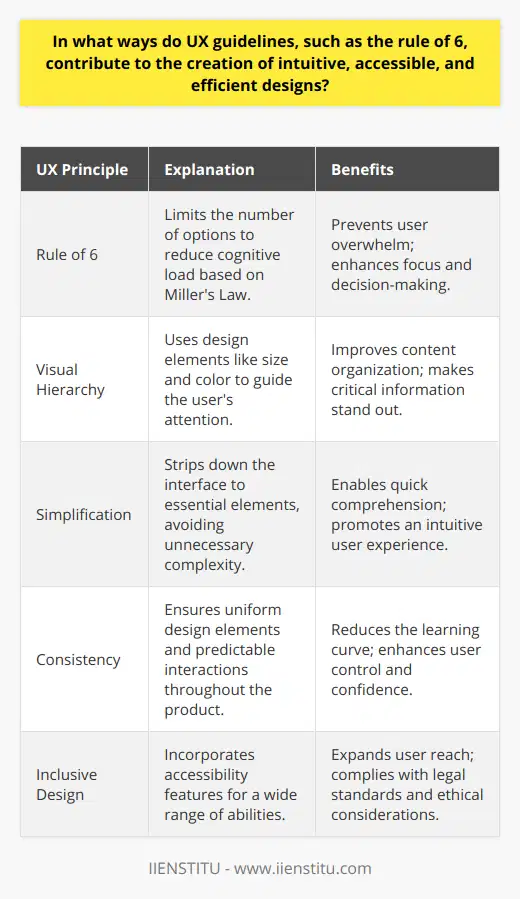
What are the 7 principles of UX design and their significance in the design process?
Understanding the Principles
The 7 principles of User Experience (UX) design play a critical role in creating efficient, engaging, and enjoyable digital products, such as websites, applications, and interfaces. These principles guide the design process by helping designers address the needs and expectations of target users.
Usability
Usability refers to the ease with which users can navigate and interact with a product or interface. Improving usability is vital to ensure that users can efficiently achieve their goals while minimizing any frustrations or challenges during their interaction with the product.
Consistency
Consistency is an essential aspect of UX design, as it enables users to quickly adapt to and learn the product's functionalities. Consistent design elements, such as layout, fonts, and buttons, allow for a smoother and more enjoyable user experience.
Feedback
Feedback refers to the direct communication between the product and users, informing them about the results of their interaction. Immediate and accurate feedback is crucial in assuring users that their actions have been executed correctly, and it helps reduce any misunderstandings or errors.
Flexibility
Flexibility enables users to customize the product's functionalities and appearance according to their preferences and needs. Providing multiple ways of accomplishing tasks or adapting the content presentation fosters a more personalized and satisfying user experience.
Minimalism
Minimalism ensures that only essential elements are included in the design, avoiding unnecessary complexity or clutter that may distract or confuse users. A minimalistic design approach results in a more efficient, focused, and accessible user experience.
User-centered design
The user-centered design principle prioritizes the needs, preferences, and characteristics of the target audience. By involving users in the design process, designers can develop solutions that genuinely address the users' requirements and expectations, leading to a more satisfying and efficient user experience.
Collaboration
Collaboration fosters the successful integration of various disciplines, such as design, development, and marketing, in the creation of a cohesive product. The collaborative approach ensures that all stakeholders contribute their expertise and perspectives, ultimately leading to a more refined and effective UX design.
In conclusion, the 7 principles of UX design serve as a reminder of the importance of putting the user first in the design process. By adhering to these principles, designers can develop digital products that not only meet users' needs but also provide engaging and enjoyable experiences.

How can UX guidelines be utilized to optimize the user experience, ensure accessibility, and streamline the design workflow?
Utilizing UX Guidelines for Optimization
To optimize the user experience, accessibility, and streamline the design workflow, it is essential to utilize UX guidelines effectively. By doing so, designers can create interfaces that are not only visually appealing but also user-friendly and accessible to a wide range of users.
Enhancing User Experience
A key aspect of employing UX guidelines is to focus on the user's needs and preferences. This includes understanding the target audience, their behavior, motivations, and pain points. By empathizing with users, designers can make informed decisions that lead to a more intuitive, efficient, and enjoyable experience. For example, following guidelines on usability, designers can create clear navigation, consistent design elements, and functional layouts that cater to user expectations, ultimately resulting in higher user satisfaction.
Ensuring Accessibility
In addition to enhancing user experience, UX guidelines help ensure accessibility for users with diverse abilities. Accessibility should be a focal point in the design process, promoting inclusive design practices. Guidelines such as the Web Content Accessibility Guidelines (WCAG) provide valuable information on designing for users with disabilities, including visual, auditory, cognitive, and motor impairments. By adhering to these guidelines, designers can create accessible interfaces that cater to a broader audience, breaking down barriers and providing equal opportunities for all users.
Streamlining the Design Workflow
Lastly, UX guidelines contribute to streamlining the design workflow, enabling designers to work more efficiently and collaboratively. The standardized set of principles and best practices provided by these guidelines serves as a foundation for the design process, reducing the time spent on research, ideation, and decision-making. Furthermore, the shared vocabulary within these guidelines allows team members to communicate more effectively, fostering a smoother workflow and resulting in a more cohesive final product.
Conclusion
Overall, the effective utilization of UX guidelines plays a crucial role in optimizing the user experience, ensuring accessibility, and streamlining the design workflow. By focusing on the user's needs, promoting inclusive design practices, and following best practices, designers can create interfaces that are not only visually appealing but also functional and accessible for a wide range of users.
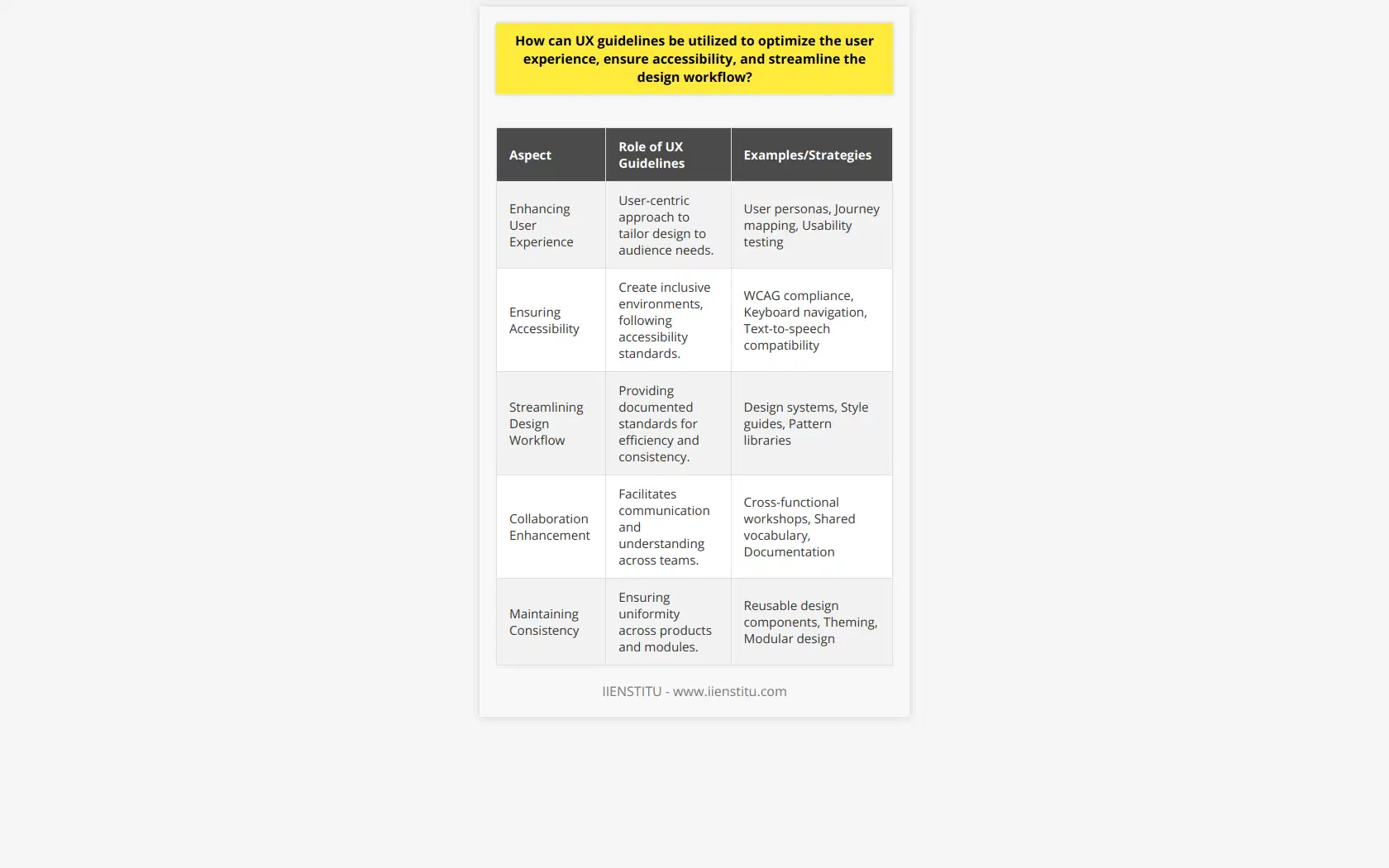
What are the key elements of UX design and how do they contribute to the overall success of a digital product?
Understanding UX Design Elements
User experience (UX) design is a crucial aspect of any digital product, as it defines the interaction between users and the product. It encompasses several key elements, each contributing to the product's overall success by ensuring a smooth, functional, and enjoyable experience for users.
Emphasizing Usability
One essential element of UX design is usability, which refers to how easily and effectively users can interact with a digital product. By prioritizing usability, designers create intuitive interfaces, simplify navigation, and reduce the learning curve for users, effectively contributing to user satisfaction and product adoption.
Incorporating User Feedback
User feedback is another critical aspect of UX design, allowing designers to continuously refine and improve the product based on user needs and preferences. This iterative process involves various research methods, such as interviews, surveys, and usability testing, to gather valuable insights from real users and make data-driven enhancements to the product.
Effective Information Architecture
Information architecture involves organizing and structuring the content and features of a digital product in a cohesive and logical manner. By crafting a well-defined information architecture, UX designers contribute to the product's success by facilitating easy access to information and seamless navigation between the user interface's sections, ultimately leading to faster task completion and a more satisfying user experience.
Focusing on Visual Design
Visual design plays a significant role in UX, as it directly affects users' perceptions and appeals to their emotions. A visually appealing user interface, combined with consistent design elements (e.g., colors, typography, and icons), affects users' overall impression and creates a sense of coherence, trust, and professionalism, thus contributing to the product's success.
Optimizing Accessibility
Accessibility is another essential element of UX design, ensuring that the digital product is usable by a wide range of users, including those with disabilities. By adopting inclusive design principles and accessibility guidelines, designers create a more equitable and inclusive product, contributing to its overall success and user satisfaction.
In conclusion, the key elements of UX design, such as usability, user feedback, information architecture, visual design, and accessibility, work together to create a seamless user experience. By adhering to these principles, UX designers can effectively contribute to the overall success of a digital product, enhancing user satisfaction and promoting product adoption.
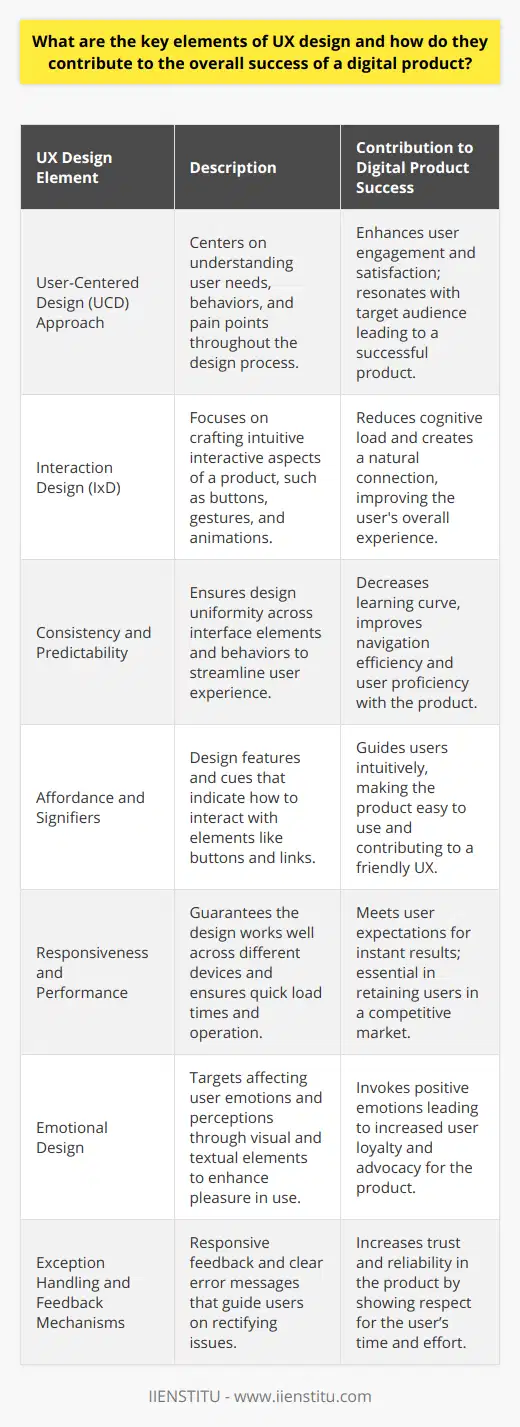
What are the 7 principles of UX design and how can they be applied to enhance user satisfaction and engagement?
The seven principles of UX design are valuable guidelines for creating user-centric designs. They include useful, usable, desirable, findable, accessible, credible, and valuable.
The first principle, 'useful,' emphasizes that a design should serve a purpose and meet user needs. This can be achieved through understanding target audiences, their needs, and crafting designs that meet these needs.
Secondly, the principle of 'usability' entails the simplicity and ease with which users can navigate through a product. Ease of use ensures user engagement and satisfaction. Usability testing can aid in gauging and improving this.
'Desirability,' the third principle, focuses on aesthetic appeal. Appealing designs attract users and can motivate them to use a product more. This can involve the use of alluring graphics, typography, and layouts.
The fourth principle, 'findable,' means that users should effortlessly locate what they need. Improved findability leads to user satisfaction and engagement. Implementing clear navigation aids and search functions can amplify this.
The fifth principle, 'accessible,' implies that designs should cater to people with various abilities. This can be achieved through color contrast for visually impaired users and easy navigation for physically impaired users.
The sixth principle of UX design, “credibility”, involves instilling trust and belief in users through reliable and secure designs. High credibility can be secured by offering accurate information, securing transactions, and prompt user support.
Last but not least, 'valuable' promotes designs that fulfill business objectives alongside user objectives. Balancing business goals with user satisfaction can enhance a product's value.
By consciously implementing these principles into design strategy, companies can significantly improve user satisfaction and engagement. Proper application of these principles leads to a satisfying user experience, which in turn leads to overall business success.
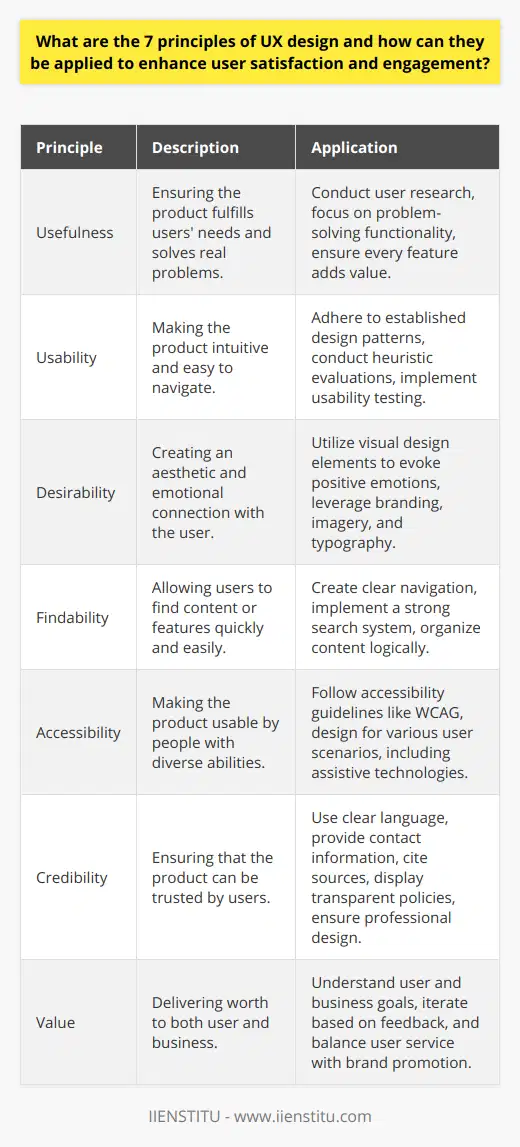
How do the 5 principles of UX design contribute to the creation of a seamless and efficient user experience?
Understanding User Goals
The five principles of User Experience (UX) design significantly contribute to a seamless and efficient user experience. First, understanding the user's goals is crucial. By conducting user research, designers can accurately determine what features will best meet a user's needs. Shape user-focused solutions based on their expected behaviors, attitudes, and desires in different contexts.
Enhancing User-Function Interaction
The second principle highlights the importance of enhancing the interaction between the user and the functions of the design. Designers must strive for simplicity, making tasks easy to understand and complete. The easier it is for users to interact with a design, the higher the efficiency and user satisfaction.
Prioritizing Usability
The third principle emphasizes prioritizing usability. An efficient UX design is one that is not only visually appealing but also usable. Usable designs are intuitive, reducing the need for users to think or make decisions - the design guides them instinctively.
Incorporating Accessible Design
The fourth principle relates to the incorporation of an accessible design. It reminds designers to account for the diverse abilities of users. A seamless user experience means that the design is inclusive and can be utilized effectively by everyone, irrespective of their abilities or disabilities.
Fostering Trust and Credibility
Finally, the fifth principle underscores the significance of fostering trust and credibility. The goal is to establish a level of confidence in the user through transparent communication, privacy protection, and consistent performance. This principle contributes to building long-term user relationships, increasing user retention, engagement, and loyalty.
In summary, the five principles of UX design work synergistically to create a more efficient, seamless, and user-focused digital experience. Each principle is fundamental in guiding designers to develop interfaces that prioritize user needs, enhance interaction, maintain usability, ensure accessibility, and foster trust.

What are the key rules for a good UX and how can they be integrated into various design stages to achieve optimal results?
Respecting Users' Predictive Patterns
A fundamental rule of good User Experience (UX) design revolves around meeting users' expectations. To do so, designers need to follow standard design conventions. Users predict where to find different features of an interface based on their past experiences.
Addressing Users' Pain Points
Focusing on users' pain points while developing a product design is vital. Conducting user research to find these pain points helps tailor designs that solve real problems instead of assumed ones.
Consideration of Users' Cognitive Load
Great UX designs should minimize cognitive load. Designers can achieve this by keeping styles, fonts, and layouts consistent. Organized and clear visual hierarchies also guide users and facilitate their understanding of the interface.
Incorporation of Feedback Mechanism
Good UX design accommodates opportunities for user feedback and encourages iterative design. User feedback allows a design to improve, ensuring it becomes more efficient and offers a better user experience.
User Accessibility Optimization
Designs should be accessible to all users, including those with disabilities. Following the Web Content Accessibility Guidelines (WCAG) ensures the inclusivity of design and widens the reach of the product.
Integration of UX Rules into Design Stages
To achieve optimal results in UX design, integrating these rules into every design stage is essential. In the ideation stage, understanding users' predictive habits and pain points should guide the design. While crafting the design, due consideration to the users' cognitive load is required. After the design, a mechanism for user feedback should be introduced. Lastly, accessibility should be guaranteed by meeting the WCAG guidelines.
Thus, considering these rules during every design stage is fundamental for achieving optimal results in UX design.
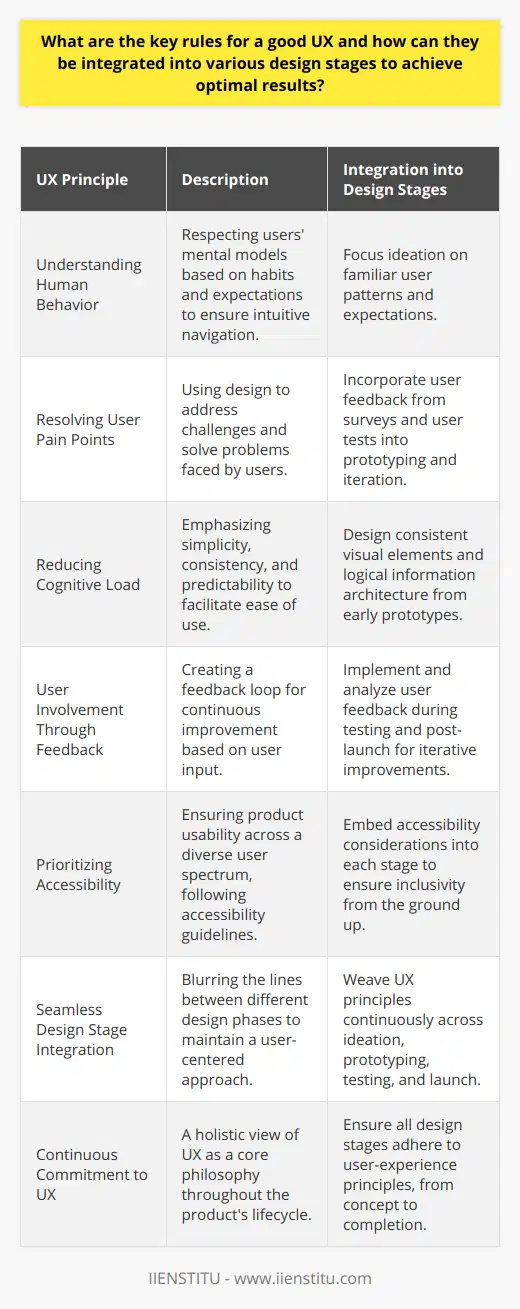
What are the 7 elements of UX and how do they contribute to a cohesive and effective user experience?
Elements of UX
User Experience (UX) stands at the crux of a successful digital product. Seven key elements contribute to creating an efficient, pleasurable UX: strategy, research, analysis, design, production, testing, and metrics.
UX Strategy and Its Importance
A UX strategy stems from an understanding of the business goals and objectives. The product must serve the user’s needs, while also benefitting the business. Defining this strategy creates direction and intention for all subsequent actions in the UX design process.
The Role of UX Research
Research involves garnering insights into the user’s needs, goals, and pain points. It entails studying market trends, competition, and target audience behaviours. This data helps in creating user personas, which represent potential users. Research ensures the product aligns with user expectations.
Analyzing UX Aspects
Analysis comes next. It includes assessing the findings from the research phase. This process helps in making informed decisions. Areas of improvement become evident during this phase.
Designing the User Experience
Design brings together research, analysis, and strategy. It incorporates visual components like layout, color, typography and imagery, along with interactive elements. This step also considers accessibility, ensuring that everyone, including people with disabilities, can use the product.
The Production Phase
Production translates the design into a useable product. Developers convert sketches, wireframes, and prototypes into a functional product. It's crucial to maintain communication between design and development teams to ensure the final product matches the envisioned design.
UX Testing for Efficiency
Testing comes at various stages in the UX process. It establishes the product’s usability and functionality. User feedback gathered during testing helps in identifying issues and implementing necessary changes.
UX Metrics and Their Impact
Finally, UX metrics help assess the effectiveness of the product. They include user satisfaction rates, task completion rates, and error rates. Regular monitoring of these metrics allows for continued improvement and optimization of the product.
Conclusion:
These seven elements of UX work together in a cyclical, iterative process. Each step builds on the last and informs the next. This ensures the development of a user-centric product that delivers a cohesive and efficient user experience.
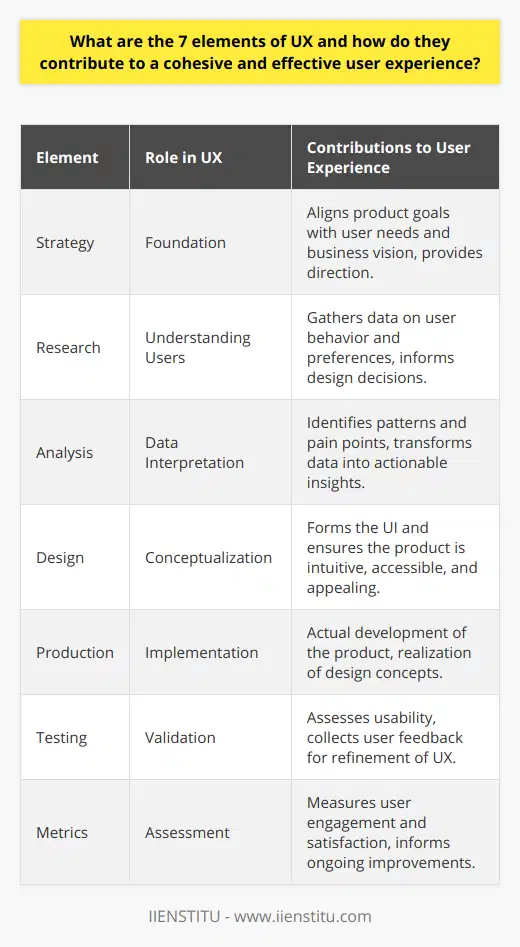
How do the 7 principles in user design interaction impact overall user satisfaction and engagement in digital products?
Principle 1: Usability
Usability affects user satisfaction due to its direct influence on how easily a user can navigate and interact with the digital product. A user-friendly interface enhances user engagement.
Principle 2: Learnability
Learnability is an aspect that enhances user engagement by making it easier for users to grasp how to use the product. A simpler learning curve means a more satisfactory experience for users.
Principle 3: Memorability
If users can remember how to use your product even after a period of non-use, their satisfaction increases. Easy memorability ensures users can quickly resume using the product, enhancing engagement.
Principle 4: Errors
How design handles errors impacts user satisfaction. Clear, helpful error messages combat frustration, while error prevention boosts confidence, leading to increased engagement.
Principle 5: Satisfaction
Designing for customer satisfaction ensures that the user’s overall experience leaves a positive impression. A pleasing design with satisfying interactions can directly influence a user’s engagement levels.
Principle 6: Efficiency
Efficient design saves users’ time and effort. Quick and easy task completion contributes to user satisfaction and promotes frequent interaction with the digital product.
Principle 7: Feedback
Immediate feedback in a user interface ensures users that their actions cause visible outcomes, enabling them to understand and control interactions. This increases their engagement and satisfaction.
In conclusion, the seven principles of user design interaction play integral roles in determining the overall user satisfaction and engagement in digital products. Attention to these principles during the design process ensures that the end result will be a product that is not only engaging but also increases user satisfaction.

What role do UX design guidelines play in informing the design process and the development of successful and accessible user interfaces?
Guiding the Design Process
UX design guidelines offer a blueprint for designers during the design process. They establish principles that designers must follow to create intuitive and user-friendly experiences. These guidelines inform decisions on design elements such as layout, color, typography, and interactions.
User Interface Development
The guidelines also play an instrumental role in user interface development. They provide insights on how to structure user interface elements for optimal usability and accessibility. By adhering to these guidelines, developers can construct interfaces that empower users to interact with digital products effortlessly.
Fostering Accessibility
Another crucial role of UX design guidelines involves promoting accessibility in design. Accessibility guidelines provide concrete ways to ensure that digital products are easy-to-use for users of all abilities. This includes considerations for individuals with visual, auditory, cognitive, and physical impairments. By promoting inclusivity, these guidelines make digital products accessible to a broader audience.
Ensuring Success
Lastly, UX design guidelines are pivotal to the development of successful digital products. Products that abide by these guidelines have proven to deliver better user experiences, which in turn leads to higher user satisfaction and user engagement rates. This results in higher conversion rates and increased product success. In essence, these guidelines serve as a cornerstone for any successful design project.
In conclusion, UX design guidelines play a multidimensional role in informing the design process and the development of successful and accessible user interfaces. They establish a roadmap for intuitive design, promote accessibility, and ultimately, lead to more successful products.
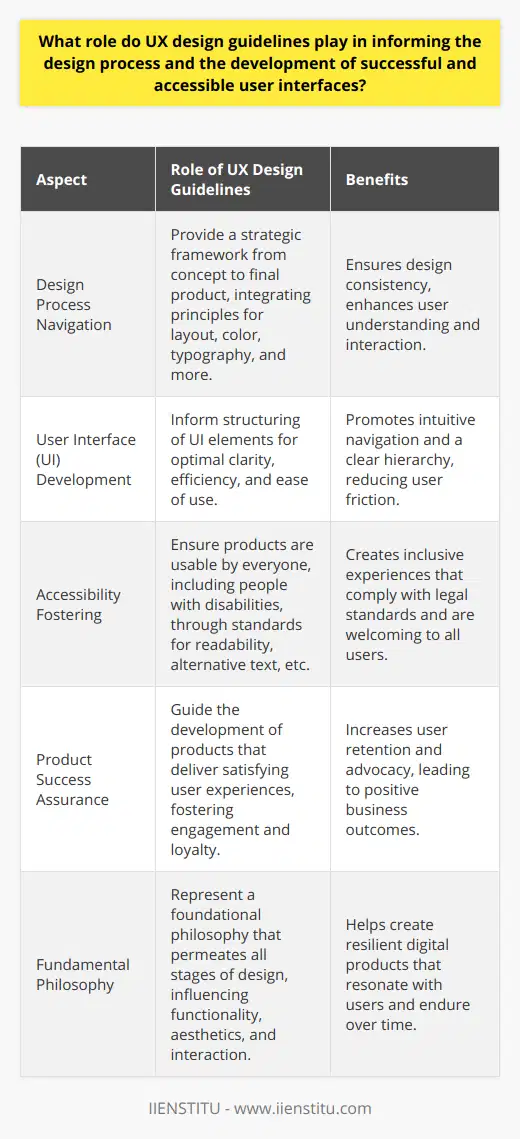
What is the basic concept of UX design?
Basic Understanding of UX Design
Comprehending UX design starts with its acronym: User Experience. The crux of UX design revolves around the user's perspective when interacting with a system. The ‘system’ isn’t only confined to websites or applications but also encompasses a vast array of products such as computers, smart devices, and even services.
Essence of UX Design
In essence, UX design does not focus merely on the creation of usable products. Instead, it aims at offering an amicable, intuitive, and enjoyable experience. This is significant in persuading and attracting users. So, the role of a UX designer goes beyond curating ease of use.
Objectives of UX Design
Primarily, UX design emphasizes reducing the gap between user expectations and product functionality. It strives to make the user’s interaction as straightforward and efficient as possible. In this context, efficiency implies accomplishing the user's goal with minimum expenditure of time and effort.
Pillars of UX Design
Two primary elements augment UX design: usability and user perspective. Usability talks about the functionality, intuitiveness, and simplicity of the interface. User perspective, on the other hand, hinges on user satisfaction, positive emotions, accomplishment, and eventually, product reusability.
Process of UX Design
UX design necessitates a detailed understanding of users, their needs, values, abilities, and limitations. Also, it requires consideration of the business goals and objectives of the product or service. Design decisions, therefore, stand on a fine balance between user needs and business requirements.
Concluding the UX Design Concept
To encapsulate, UX design forms the foundation for successful interface creation. It swings around optimal user experience. The discipline holds the vision to bring satisfaction and enjoyment to users while also meeting business aspirations. The end game of UX design is to make the user’s interaction simple, efficient, and enjoyable as far as possible.
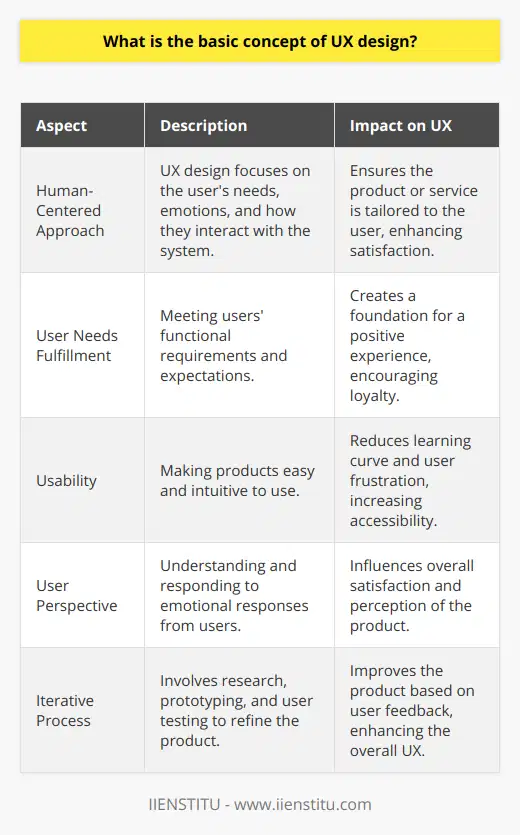
What are the principles of good UX design journal?
Understanding User Needs:
Good User Experience (UX) design begins with a fundamental understanding of the users' needs. UX designers must uncover and interpret user behavior, motivations, and needs before defining design direction. Direct interactions with potential users yield valuable insights, transforming intuitions into valid user-centered solutions.
Designing for Usefulness and Usability:
UX design should aim for usefulness and usability. A good design not only fulfills users' needs but is also easy to use and understand. It assures smooth navigation with simple steps that enable users to reach their goals quicker.
Creating Consistency:
Consistency is another crucial principle of good UX design. Identical design concepts across different devices and platforms enhance user understanding. This can range from maintaining the same color themes, design elements, or terminology across the product interface.
Enhancing Accessibility:
True UX design caters to users across different backgrounds and abilities. Ensuring universal accessibility means incorporating design approaches that support a wider range of people, including those with disabilities and older audiences.
Feedback and Iteration:
An effective UX design process involves the constant gathering of user feedback. Designers should iterate and refine concepts based on this feedback. This practice ensures designs stay user-centered and keeps improving over time.
Final Thoughts:
Understanding the essence of UX design requires acknowledging that it is a science revolving around users' needs. The principles discussed here stress the need for a profound user understanding, design simplicity, consistency, accessibility, and constant improvement. In essence, good UX design puts the users first, ensuring a smooth, enjoyable interaction with the product.
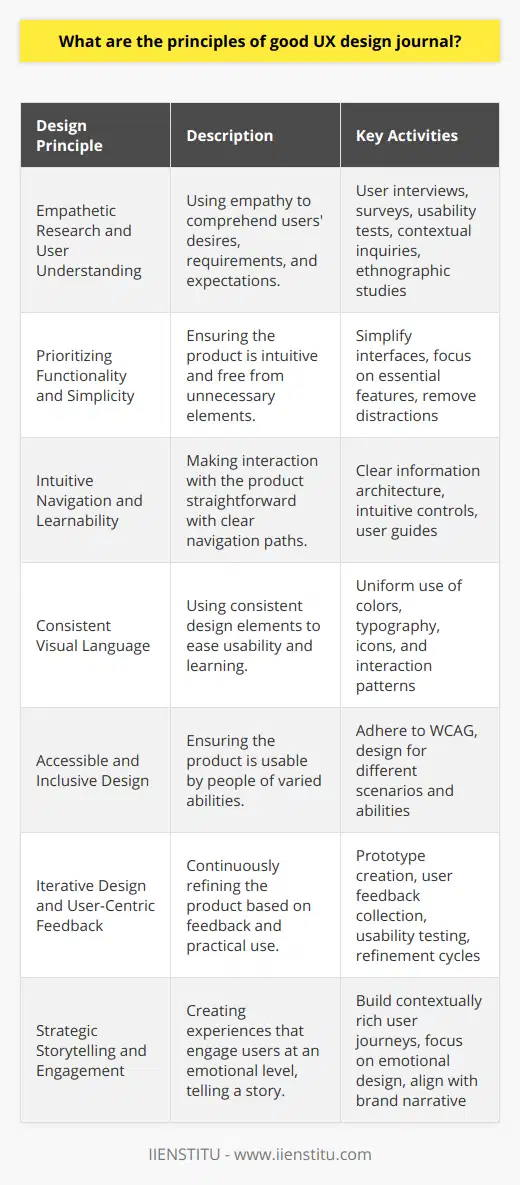
What are the 7 principles of user experience and how do they contribute to the overall effectiveness of a digital product?
User Experience Principles
The designing of digital products heavily relies on user experience (UX) principles. The first principle is 'Usefulness.' Products must serve a purpose that caters to users' needs. Ensuring usefulness increases user satisfaction.
The second principle is 'Usability.' It defines how easily users can understand a product. A usable product requires less time and mental effort, boosting usage rates.
The third principle, 'Findability,' concerns ease of locating the desired information. User-friendly navigation and search functionalities contribute to a positive user experience.
Fourthly, 'Credibility' establishes the trustworthiness of a product. Secure platforms and transparent information strengthen user confidence, fostering loyalty.
The fifth principle is 'Desirability,' which plays a crucial role in attracting and retaining users. Aesthetically pleasing design elements, coupled with emotional appeal, enhance desirability.
The sixth principle, 'Accessibility,' ensures that products are usable by people with differing abilities. Ensuring accessibility broadens the user base and conveys inclusivity.
Finally, 'Value' determines whether the benefits of using a product outweigh its cost. It is crucial in securing users' commitment to the product.
In summation, these principles shape the user experience of a digital product. They contribute to the product's effectiveness by driving user engagement. By guaranteeing usefulness, usability, findability, credibility, desirability, accessibility, and value, these principles ensure a satisfying experience for users. Products adhering to these principles are likely to realize higher adoption and retention rates, demonstrating overall effectiveness.
